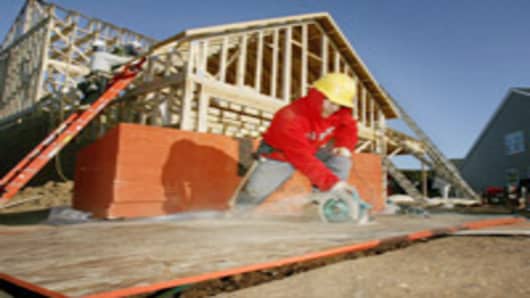When it comes to the economic recovery, the real estate and housing businesses are in very different places.
Though sales of existing homes appear to be bouncing back—as cheap foreclosure properties attract vulture investors and first-time buyers—the market for new homes remains stuck below sea level.
“It’s a very one-dimensional recovery,” says National Association of Home Builders CEO Gerald M. Howard. “The rest of the housing market is still in a recessionary stage.
In that context, recent housing data showing a modest rebound from the extreme lows of the past winter (housing starts and new home sales are up in three of the past four months) may barely qualify as encouraging.
“The improvement … looks likely to continue but is not likely to follow the abrupt V-shape of previous housing recoveries,” Nomura’s economic team said in a recent note. “Instead, a moderate uptrend is most likely to continue until the overall economy shows more consistent progress out of the recession."
Room For Improvement
By virtually every measure, the new single-family home market remains in a fairly deep slump:
- Sales of new homes are down 72 percent from their 2005 peak, while existing ones are off 24 percent from their peak a year later.
- As a percentage of total sales, new homes are well off their historical average of roughly of 12.5 percent and the 16-percent average share of the 2005-2006 boom period. In 2008, market share was down to 10 percent and is running under 8 percent so far this year.
- Inventory, which peaked at 14-3-months of supply in January, is down to 7.9 percent, but still far from the 5.9-percent level of December 2006, right as the market was turning lower.
- Housing starts overall are down 71-percent from 2005
“Most builders aren’t putting shovels in the dirt, nor are they going to anytime soon,” says Howard.
“Who knows if we’re at the bottom," adds David Tschetter, CEO of Fort Collins-based Colorado Custom Homes, whose houses average about $500,000. “We been trying to dump inventory.”
Tschetter says he’ll be lucky to build six to ten homes this year, versus a couple dozen in the boom years of 2005-2006.
With numbers like those, virtually every trade group related to real estate and housing are pushing for an expansion of the government’s existing homebuyer’s tax credit, which is now limited to first-time buyers of primary residences and a maximum of $8,000.
Help for Homebuyers
There are various bills in Congress, two of which have more than a dozen sponsors, but none of them have advanced because of a lack of votes. The most generous proposal would expand the credit to $15,000—the limit in the Senate version of the stimulus bill, which was watered down in the final draft—and apply the credit to new as well as existing homes.
“The problem in our marketplace is the move-up market, which is basically dead," Sen. Johnny Isakson (R-Ga.), a leading Senate sponsor recently told CNBC.com. "This is a housing recession feeding on itself."
In as much supporters credit the current homebuyer credit, which expires Nov. 30, they are quick to note that its impact has been limited to the lower end of the market.
National Association of Realtors data support that. Homes priced under $250,000 are up almost 17.8 percent year over year through June. In contrast, sales are down 13.3 percent in the $250,000-$500,000 bracket, 18.6 percent in the $500,000-$1 million one and 32.7 percent in the $1-4 million range during the same period. Transactions in the latter three groups are much more likely to involve the trade up to a new home.
The current tax credit—by various estimates—is expected to generate 200,000 to 300,000 new and existing home sales that would not otherwise taken place. At the existing combined annual sales rate of roughly 5.27 million properties, that’s about half of 1 percent.
Supporters of an expanded tax credit also point to California—one of the hardest hit markets--where a 2009 homebuyer program geared specifically for new homes exceeded projected demand and exhausted allocated funding.
The $100-million program—providing as much as a $10,000 credit over three years—attracted 10.5 million people.
"It's given people the conifdence to go back into the marketplace," says Tim Coyle, SVP of governmental affairs for the state builder's group.
Coyle sales a survey of members shows 75-85 percent of new housing starts can be attributed to the tax credit. Both sales and starts are up since the program started in March.
The homebuilder's association and others attribute the higher-end slump to obstacles at both ends of the transaction. Builders like Tschetter say they face difficult and unfair financing and appraisal conditions, while potential buyers are hampered by unduly tight credit standards (which is much less of an issue at the lower end where the FHA is insuring tens of thousands of mortgages with very high-loan to value ration for buyers with less-than-stellar credit) and the seemingly endless decline in prices in the existing-home segment.
“The downturn in the housing market makes a prime opportunity for first time buyers," says Robert A. Kleinhenz, deputy chief economist with the California Association of Realtors. "One of the obstacles for repeat-buyers trading up is that they may be underwater with their current mortgage. Also, would-be sellers aren't sure we've hit bottom, so they will wait, knowing the chance of consummating a successful sale will be higher and they won't be competing with as many distressed properties."
The homebuilders trade group projects a one-year extension of the $8000 credit along with its expansion to repeat buyers would generate the sale of 380,000 homes as well as the construction of 80,000 new homes that would not otherwise take place. Of the 350,000 jobs that would be generated, about a third would be in construction.
Economic Impact
Any trickle down might be more than evident in some depressed sectors of the retail sector. Sales of furniture and household furnishings, for instance, are at 2001 levels, while building materials and garden equipment/supplies are at 2004 levels.
“The ancillary fallout from this is hideous," says Tschetter, the Colorado builder. “it’s the service industry, engineers, movers, furniture makers. This is a huge jobs issue.”
Supporters also point to a $2000 credit for new homebuyers in 1975, which equates to $8000-$10000 in inflation adjusted dollars today, depending on the measure. The program was intended to reduce both home inventories and construction sector unemployment.
Sales jumped 25 percent in the first year while housing starts doubled in two years. Residential investment averaged 27 percent over a four-quarter period in 1975-1976.
“We’ve seen $8000 work in the first-time market,” says Robert Dietz, an economist with the National Association of Home Builders. “If you want to expand the buyer market you have to expand the credit.”
The trickle-down effect is likely to be noticeable, especially for some depressed areas of the retail sector. Sales of furniture and household furnishings, for example, are at 2001 levels, while those of building materials and garden equipment/ supplies are where they were in early 2004.
Timing could be critical. Sponsors are expected to make another push in the fall after Congress returns from recess. Meanwhile, interest rates remain low, consumer confidence has improved, along with the stock market, and job losses appear to ebbing.
“It does feel as if the fence sitters are looking for reasons to jump in on the side of buying,” Robert Toll, CEO of luxury builder Toll Brothers , said recently in the luxury homebuilder’ preliminary fiscal third-quarter results. ”Price is no longer the overwhelmingly dominant factor.”
Housing, which accounts for 20-percent of the economy, has always played a key role in recovery periods, as the 1975-1976 data indicates, and there’s now growing debate about the pace of growth following the recession’s end.
“There’s been so much focus on the foreclosure issue that Congress has lost tract of the demand issue,” says Richard A. Smith, CEO of real estate giant Realogy and chairman of the Business Roundtables working group on real estate. “You either make the market or incentivize it. You have to tackle the move-up market and you only have to do a little to move up a [person's] decision to move from two-three years out to now.”




